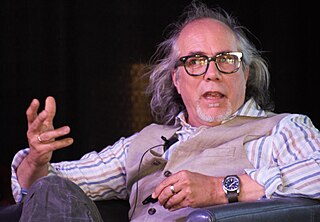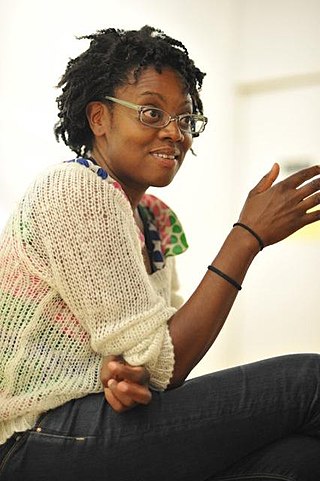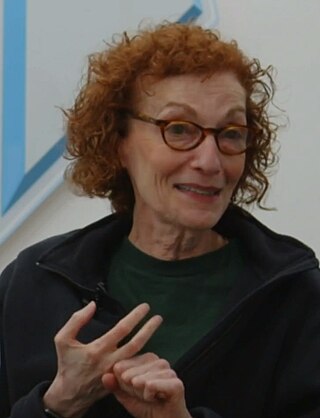Related Research Articles
Trenton Doyle Hancock is an American artist working with prints, drawings, and collaged-felt paintings. Through his work, Hancock mainly aims to tell the story of the Mounds, mystical creatures that are part of the artist's world. In this sense, each new artwork is the artist's contribution to the development of Mounds.

Kiki Smith is a German-born American artist whose work has addressed the themes of sex, birth and regeneration. Her figurative work of the late 1980s and early 1990s confronted subjects such as AIDS, feminism, and gender, while recent works have depicted the human condition in relationship to nature. Smith lives and works in the Lower East Side, New York City, and the Hudson Valley, New York State.
Janine Antoni is a Bahamian–born American artist, who creates contemporary work in performance art, sculpture, and photography. Antoni's work focuses on process and the transitions between the making and finished product, often portraying feminist ideals. She emphasizes the human body in her pieces, such as her mouth, hair, eyelashes, and, through technological scanning, brain, using it as a tool of creation or as the subject of her pieces, exploring intimacy between the spectator and the artist. Her work blurs the distinction between performance art and sculpture.

Stephanie Syjuco, is a Filipino-born American conceptual artist and educator. She works in photography, sculpture, and installation art. Born in the Philippines, she moved to the San Francisco Bay Area in 1977. She lives in Oakland, California, and teaches art at the University of California, Berkeley.
Howard Fried is an American conceptual artist who became known in the 1970s for his pioneering work in video art, performance art, and installation art.
Charles Atlas is a video artist and film director who also does lighting and set design.

Iñigo Manglano-Ovalle is an American conceptual artist known for multidisciplinary, socially oriented sculpture, video and installations and urban community-based projects of the 1990s. His work often explores a dialectical relationships involving minimalist aesthetics, the utopian ambitions of modernism and science, and the resulting—often negative—social, geopolitical and ecological consequences of such ideologies. New York Times critic Holland Cotter wrote that Manglano-Ovalle was adept in "distilling complex ideas into inviting visual metaphors," while Jody Zellen described his work as "infused with a formal elegance and sociopolitical content." Manglano-Ovalle has been featured in solo exhibitions at the Art Institute of Chicago, MASS MoCA, Museo Tamayo Arte Contemporaneo and Museum of Contemporary Art, Chicago (MCA), and participated in Documenta 12, the Venice Biennale, Whitney Biennial, and Bienal de São Paulo. He has been recognized with MacArthur Foundation, Guggenheim, and National Endowment for the Arts fellowships and his work belongs to the collections of forty major institutions. He has been a professor at Northwestern University since 2012 and lives and works in Chicago.
Dawn Kasper is a New York-based interdisciplinary artist working across genres of performance, installation, sculpture, drawing, photography, video, and sound. Her often improvisational work derives from a "fascination with existentialism, subjects of vulnerability, desire, and the construction of meaning." Kasper uses props, costume, comedy, gesture, repetition, music, and monologue to create what she refers to as "living sculptures."

Cauleen Smith is an American born filmmaker and multimedia artist. She is best known for her feature film Drylongso and her experimental works that address the African-American identity, specifically the issues facing black women today. Smith is currently a professor in the Department of Art at the University of California - Los Angeles.
Saya Woolfalk is an American artist known for her multimedia exploration of hybridity, science, race and sex. Woolfalk uses science fiction and fantasy to reimagine the world in multiple dimensions.
Mika Rottenberg is a contemporary Argentine born US based video artist who lives and works in New York. Rottenberg is best known for her video and installation work that often "investigates the link between the female body and production mechanisms". Her work has been exhibited both nationally and internationally.

Simone Leigh is an American artist from Chicago who works in New York City in the United States. She works in various media including sculpture, installations, video, performance, and social practice. Leigh has described her work as auto-ethnographic, and her interests include African art and vernacular objects, performance, and feminism. Her work is concerned with the marginalization of women of color and reframes their experience as central to society. Leigh has often said that her work is focused on “Black female subjectivity,” with an interest in complex interplays between various strands of history. She was named one of the 100 most influential people in the world by Time magazine in 2023.
Laylah Ali (born 1968) is an American contemporary visual artist. She is known for paintings in which ambiguous race relations are depicted with a graphic clarity and cartoon strip format. She lives in Williamstown, Massachusetts, and is a professor at Williams College.
Rosana Castrillo Diaz is a Spanish artist.

Jennie C. Jones is an African-American artist living and working in Brooklyn, New York. Her work has been described, by Ken Johnson, as evoking minimalism, and paying tribute to the cross-pollination of different genres of music, especially jazz. As an artist, she connects most of her work between art and sound. Such connections are made with multiple mediums, from paintings to sculptures and paper to audio collages. In 2012, Jones was the recipient of the Joyce Alexander Wien Prize, one of the biggest awards given to an individual artist in the United States. The prize honors one African-American artist who has proven their commitment to innovation and creativity, with an award of 50,000 dollars. In December 2015 a 10-year survey of Jones's work, titled Compilation, opened at the Contemporary Arts Museum in Houston, Texas.
Park McArthur is a conceptual artist living in New York City who works in sculpture, installation, text, and sound. McArthur is a wheelchair user whose work uses this position to inform her art.

Beverly Fishman is an American painter and sculptor whose work explores science, medicine, and the body. She is a Guggenheim Fellow, a National Academy of Design Academician, an Anonymous Was a Woman awardee, and was Artist-in-Residence at Cranbrook Academy of Art between 1992 and 2019, where she was Head of the Painting Department. Although best known for her painted reliefs based on the forms of drugs and pharmaceuticals, Fishman has consistently worked in multiple media, such as cast-resin and glass sculpture, as well as silkscreen painting on metal, large-scale wall painting, and outdoor murals. While Fishman's artworks often look abstract, they are based on appropriated shapes, patterns, and images drawn from the pharmaceutical and illicit drug industries as well as multiple forms of scientific and medical imaging. As she noted in 2017, "Although they look abstract, my paintings are tied to problems like attention-deficit disorder, opioid addiction, anxiety, and depression. Their forms connect them to the social problems of today."
Rebeca Bollinger is an American artist. She works with sculpture, photography, video, drawing, installation, writing and sound.

Rose B. Simpson is a Tewa sculptor of Khaʼpʼoe Ówîngeh is a mixed-media artist who works in ceramic, metal, fashion, painting, music, performance, and installation. She lives and works in Santa Clara Pueblo, New Mexico. Her work has been exhibited at SITE Santa Fe ; the Heard Museum ; the Museum of Contemporary Native Art, Santa Fe (2010); the National Museum of the American Indian, Smithsonian (2008); the Denver Art Museum; Pomona College Museum of Art (2016); Ford Foundation Gallery (2019); The Wheelwright Museum of the American Indian (2017); the Minneapolis Institute of Art (2019); the Savannah College of Art and Design (2020); the Nevada Museum of Art (2021); Whitney Museum of American Art, and the Norton Museum of Art (2024).
Summer Wheat is a contemporary American artist born in 1977 in Oklahoma City. She currently lives in Queens, NY and works in Brooklyn, NY.
References
- ↑ "Mika Tajima — Art21". Art21. Retrieved 2018-03-09.
- ↑ "Mika Tajima - Artists + Projects - 11R Gallery". 11rgallery.com. 2016-12-02. Archived from the original on 2020-05-20.
- ↑ "Mika Tajima :: Foundation for Contemporary Arts". www.foundationforcontemporaryarts.org. Retrieved 2019-05-09.
- ↑ "Mika Tajima: The Double, Press Release" (PDF). The Kitchen. Retrieved 21 March 2018.
- ↑ "MIKA TAJIMA: THE DOUBLE". The Bass Museum of Art. Retrieved 21 March 2018.
- ↑ Maerkle, Andrew (8 September 2010). "Alienation Through Beautification, Engagement After Alienation". ART iT. Retrieved 21 March 2018.
- ↑ "Mika Tajima :: Foundation for Contemporary Arts". www.foundationforcontemporaryarts.org. Retrieved 2019-05-09.
- ↑ "Mika Tajima". 11th Gwangju Biennale 2016. Retrieved 21 March 2018.
- ↑ Norton, Margot. "Mika Tajima: Æther" (PDF). Borusan Contemporary. Retrieved 21 March 2018.
- ↑ Lyon, Matthew (October 20, 2015). Total Body Conditioning: Mika Tajima. Black Dog Publishing. ISBN 978-1908966971.
- ↑ "Japanese artist's work inspired by abstract material at Bosporus Gallery". DailySabah. 2 March 2018. Retrieved 9 March 2018.
- ↑ Uncu, Erman Ata (8 March 2018). "Perili Köşk'te teknolojik hayalet avı". Hürriyet (in Turkish). Retrieved 9 March 2018.
- ↑ Smith, Roberta (2014-03-27). "Mika Tajima: 'Negative Entropy'". The New York Times. ISSN 0362-4331 . Retrieved 2018-03-09.
- ↑ "Artist Mika Tajima on Shaping the Human Body Through Sculpture". Artspace. Retrieved 2018-03-09.
- ↑ "Mika Tajima by Kareem Estefan - BOMB Magazine". bombmagazine.org. Retrieved 2018-03-09.
- ↑ "New Humans official". New Humans official. New Humans. Retrieved 24 March 2018.
- ↑ "SFMOMA'S LIVE-ART PROGRAM PRESENTSTODAY IS NOT A DRESS REHEARSAL, BY NEW HUMANS". SFMOMA. Retrieved 2018-04-30.
- ↑ "Charles Atlas & Mika Tajima: The Pedestrians at South London Gallery, London •Mousse Magazine". moussemagazine.it (in Italian). 13 April 2011. Retrieved 2018-04-30.
- ↑ Huldisch, Henriette; Momin, Shamim M. (2008-03-28). Whitney Biennial 2008. New Haven, Conn.: The Whitney Museum of American Art. ISBN 9780300136890.
- ↑ "Mika Tajima". Artadia. 3 May 2017. Retrieved 2019-06-11.